Jiantao Qiu
Hallucination at a Glance: Controlled Visual Edits and Fine-Grained Multimodal Learning
Jun 08, 2025Abstract:Multimodal large language models (MLLMs) have achieved strong performance on vision-language tasks but still struggle with fine-grained visual differences, leading to hallucinations or missed semantic shifts. We attribute this to limitations in both training data and learning objectives. To address these issues, we propose a controlled data generation pipeline that produces minimally edited image pairs with semantically aligned captions. Using this pipeline, we construct the Micro Edit Dataset (MED), containing over 50K image-text pairs spanning 11 fine-grained edit categories, including attribute, count, position, and object presence changes. Building on MED, we introduce a supervised fine-tuning (SFT) framework with a feature-level consistency loss that promotes stable visual embeddings under small edits. We evaluate our approach on the Micro Edit Detection benchmark, which includes carefully balanced evaluation pairs designed to test sensitivity to subtle visual variations across the same edit categories. Our method improves difference detection accuracy and reduces hallucinations compared to strong baselines, including GPT-4o. Moreover, it yields consistent gains on standard vision-language tasks such as image captioning and visual question answering. These results demonstrate the effectiveness of combining targeted data and alignment objectives for enhancing fine-grained visual reasoning in MLLMs.
Multi-Step Visual Reasoning with Visual Tokens Scaling and Verification
Jun 08, 2025Abstract:Multi-modal large language models (MLLMs) have achieved remarkable capabilities by integrating visual perception with language understanding, enabling applications such as image-grounded dialogue, visual question answering, and scientific analysis. However, most MLLMs adopt a static inference paradigm, encoding the entire image into fixed visual tokens upfront, which limits their ability to iteratively refine understanding or adapt to context during inference. This contrasts sharply with human perception, which is dynamic, selective, and feedback-driven. In this work, we introduce a novel framework for inference-time visual token scaling that enables MLLMs to perform iterative, verifier-guided reasoning over visual content. We formulate the problem as a Markov Decision Process, involving a reasoner that proposes visual actions and a verifier, which is trained via multi-step Direct Preference Optimization (DPO), that evaluates these actions and determines when reasoning should terminate. To support this, we present a new dataset, VTS, comprising supervised reasoning trajectories (VTS-SFT) and preference-labeled reasoning comparisons (VTS-DPO). Our method significantly outperforms existing approaches across diverse visual reasoning benchmarks, offering not only improved accuracy but also more interpretable and grounded reasoning processes. These results demonstrate the promise of dynamic inference mechanisms for enabling fine-grained, context-aware visual reasoning in next-generation MLLMs.
Not All Documents Are What You Need for Extracting Instruction Tuning Data
May 18, 2025Abstract:Instruction tuning improves the performance of large language models (LLMs), but it heavily relies on high-quality training data. Recently, LLMs have been used to synthesize instruction data using seed question-answer (QA) pairs. However, these synthesized instructions often lack diversity and tend to be similar to the input seeds, limiting their applicability in real-world scenarios. To address this, we propose extracting instruction tuning data from web corpora that contain rich and diverse knowledge. A naive solution is to retrieve domain-specific documents and extract all QA pairs from them, but this faces two key challenges: (1) extracting all QA pairs using LLMs is prohibitively expensive, and (2) many extracted QA pairs may be irrelevant to the downstream tasks, potentially degrading model performance. To tackle these issues, we introduce EQUAL, an effective and scalable data extraction framework that iteratively alternates between document selection and high-quality QA pair extraction to enhance instruction tuning. EQUAL first clusters the document corpus based on embeddings derived from contrastive learning, then uses a multi-armed bandit strategy to efficiently identify clusters that are likely to contain valuable QA pairs. This iterative approach significantly reduces computational cost while boosting model performance. Experiments on AutoMathText and StackOverflow across four downstream tasks show that EQUAL reduces computational costs by 5-10x and improves accuracy by 2.5 percent on LLaMA-3.1-8B and Mistral-7B
Meta-rater: A Multi-dimensional Data Selection Method for Pre-training Language Models
Apr 19, 2025Abstract:The composition of pre-training datasets for large language models (LLMs) remains largely undisclosed, hindering transparency and efforts to optimize data quality, a critical driver of model performance. Current data selection methods, such as natural language quality assessments, diversity-based filters, and classifier-based approaches, are limited by single-dimensional evaluation or redundancy-focused strategies. To address these gaps, we propose PRRC to evaluate data quality across Professionalism, Readability, Reasoning, and Cleanliness. We further introduce Meta-rater, a multi-dimensional data selection method that integrates these dimensions with existing quality metrics through learned optimal weightings. Meta-rater employs proxy models to train a regression model that predicts validation loss, enabling the identification of optimal combinations of quality scores. Experiments demonstrate that Meta-rater doubles convergence speed for 1.3B parameter models and improves downstream task performance by 3.23, with scalable benefits observed in 3.3B models trained on 100B tokens. Additionally, we release the annotated SlimPajama-627B dataset, labeled across 25 quality metrics (including PRRC), to advance research in data-centric LLM development. Our work establishes that holistic, multi-dimensional quality integration significantly outperforms conventional single-dimension approaches, offering a scalable paradigm for enhancing pre-training efficiency and model capability.
WanJuanSiLu: A High-Quality Open-Source Webtext Dataset for Low-Resource Languages
Jan 24, 2025



Abstract:This paper introduces the open-source dataset WanJuanSiLu, designed to provide high-quality training corpora for low-resource languages, thereby advancing the research and development of multilingual models. To achieve this, we have developed a systematic data processing framework tailored for low-resource languages. This framework encompasses key stages such as data extraction, corpus cleaning, content deduplication, security filtering, quality evaluation, and theme classification. Through the implementation of this framework, we have significantly improved both the quality and security of the dataset, while maintaining its linguistic diversity. As of now, data for all five languages have been fully open-sourced. The dataset can be accessed at https://opendatalab.com/applyMultilingualCorpus, and GitHub repository is available at https://github.com/opendatalab/WanJuan3.0
Harnessing Diversity for Important Data Selection in Pretraining Large Language Models
Sep 25, 2024Abstract:Data selection is of great significance in pre-training large language models, given the variation in quality within the large-scale available training corpora. To achieve this, researchers are currently investigating the use of data influence to measure the importance of data instances, $i.e.,$ a high influence score indicates that incorporating this instance to the training set is likely to enhance the model performance. Consequently, they select the top-$k$ instances with the highest scores. However, this approach has several limitations. (1) Computing the influence of all available data is time-consuming. (2) The selected data instances are not diverse enough, which may hinder the pre-trained model's ability to generalize effectively to various downstream tasks. In this paper, we introduce \texttt{Quad}, a data selection approach that considers both quality and diversity by using data influence to achieve state-of-the-art pre-training results. In particular, noting that attention layers capture extensive semantic details, we have adapted the accelerated $iHVP$ computation methods for attention layers, enhancing our ability to evaluate the influence of data, $i.e.,$ its quality. For the diversity, \texttt{Quad} clusters the dataset into similar data instances within each cluster and diverse instances across different clusters. For each cluster, if we opt to select data from it, we take some samples to evaluate the influence to prevent processing all instances. To determine which clusters to select, we utilize the classic Multi-Armed Bandit method, treating each cluster as an arm. This approach favors clusters with highly influential instances (ensuring high quality) or clusters that have been selected less frequently (ensuring diversity), thereby well balancing between quality and diversity.
InternLM2 Technical Report
Mar 26, 2024
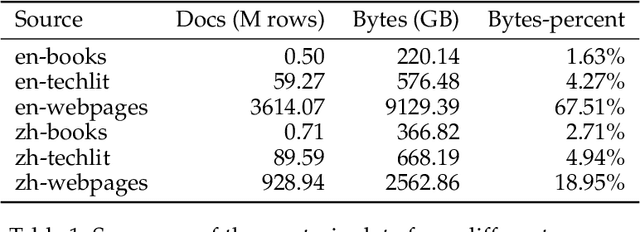
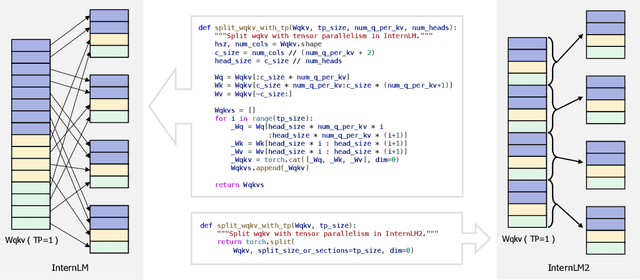

Abstract:The evolution of Large Language Models (LLMs) like ChatGPT and GPT-4 has sparked discussions on the advent of Artificial General Intelligence (AGI). However, replicating such advancements in open-source models has been challenging. This paper introduces InternLM2, an open-source LLM that outperforms its predecessors in comprehensive evaluations across 6 dimensions and 30 benchmarks, long-context modeling, and open-ended subjective evaluations through innovative pre-training and optimization techniques. The pre-training process of InternLM2 is meticulously detailed, highlighting the preparation of diverse data types including text, code, and long-context data. InternLM2 efficiently captures long-term dependencies, initially trained on 4k tokens before advancing to 32k tokens in pre-training and fine-tuning stages, exhibiting remarkable performance on the 200k ``Needle-in-a-Haystack" test. InternLM2 is further aligned using Supervised Fine-Tuning (SFT) and a novel Conditional Online Reinforcement Learning from Human Feedback (COOL RLHF) strategy that addresses conflicting human preferences and reward hacking. By releasing InternLM2 models in different training stages and model sizes, we provide the community with insights into the model's evolution.
WanJuan-CC: A Safe and High-Quality Open-sourced English Webtext Dataset
Mar 12, 2024
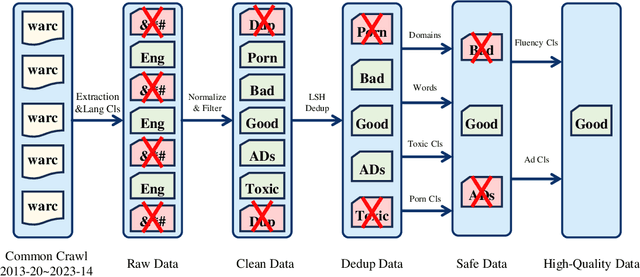
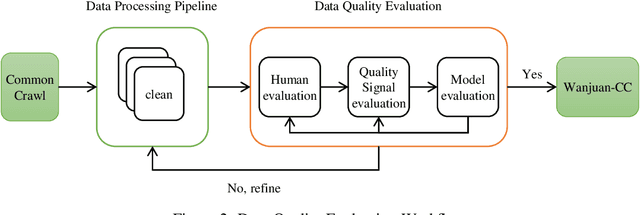

Abstract:This paper presents WanJuan-CC, a safe and high-quality open-sourced English webtext dataset derived from Common Crawl data. The study addresses the challenges of constructing large-scale pre-training datasets for language models, which require vast amounts of high-quality data. A comprehensive process was designed to handle Common Crawl data, including extraction, heuristic rule filtering, fuzzy deduplication, content safety filtering, and data quality filtering. From approximately 68 billion original English documents, we obtained 2.22T Tokens of safe data and selected 1.0T Tokens of high-quality data as part of WanJuan-CC. We have open-sourced 100B Tokens from this dataset. The paper also provides statistical information related to data quality, enabling users to select appropriate data according to their needs. To evaluate the quality and utility of the dataset, we trained 1B-parameter and 3B-parameter models using WanJuan-CC and another dataset, RefinedWeb. Results show that WanJuan-CC performs better on validation datasets and downstream tasks.
WanJuan: A Comprehensive Multimodal Dataset for Advancing English and Chinese Large Models
Aug 22, 2023Abstract:The rise in popularity of ChatGPT and GPT-4 has significantly accelerated the development of large models, leading to the creation of numerous impressive large language models(LLMs) and multimodal large language models (MLLMs). These cutting-edge models owe their remarkable performance to high-quality data. However, the details of the training data used in leading paradigms are often kept confidential. This lack of transparency, coupled with the scarcity of open-source data, impedes further developments within the community. As a response, this paper presents "Wan Juan", a large-scale multimodal dataset composed of both Chinese and English data, collected from a wide range of web sources. The dataset incorporates text, image-text, and video modalities, with a total volume exceeding 2TB. It was utilized in the training of InternLM, a model that demonstrated significant advantages in multi-dimensional evaluations when compared to models of a similar scale. All data can be accessed at https://opendatalab.org.cn/WanJuan1.0.
Explore-Bench: Data Sets, Metrics and Evaluations for Frontier-based and Deep-reinforcement-learning-based Autonomous Exploration
Feb 24, 2022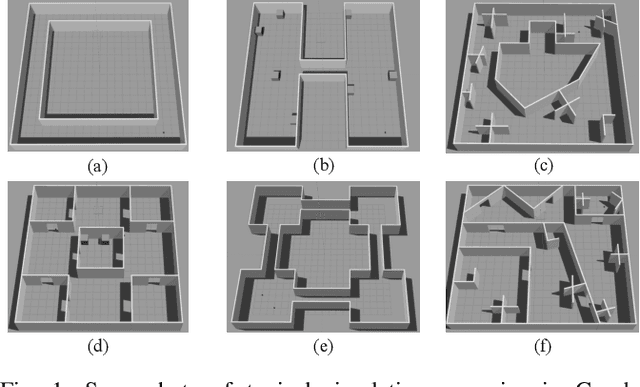
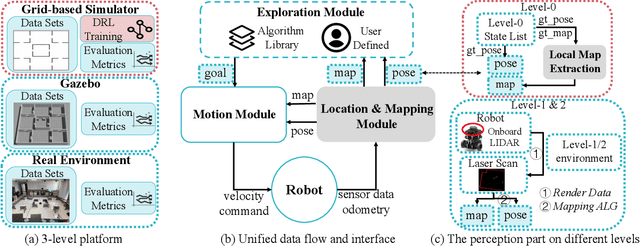
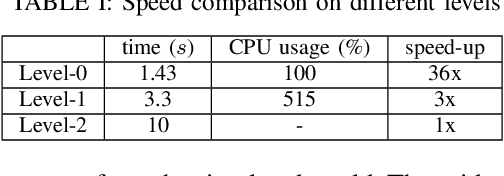

Abstract:Autonomous exploration and mapping of unknown terrains employing single or multiple robots is an essential task in mobile robotics and has therefore been widely investigated. Nevertheless, given the lack of unified data sets, metrics, and platforms to evaluate the exploration approaches, we develop an autonomous robot exploration benchmark entitled Explore-Bench. The benchmark involves various exploration scenarios and presents two types of quantitative metrics to evaluate exploration efficiency and multi-robot cooperation. Explore-Bench is extremely useful as, recently, deep reinforcement learning (DRL) has been widely used for robot exploration tasks and achieved promising results. However, training DRL-based approaches requires large data sets, and additionally, current benchmarks rely on realistic simulators with a slow simulation speed, which is not appropriate for training exploration strategies. Hence, to support efficient DRL training and comprehensive evaluation, the suggested Explore-Bench designs a 3-level platform with a unified data flow and $12 \times$ speed-up that includes a grid-based simulator for fast evaluation and efficient training, a realistic Gazebo simulator, and a remotely accessible robot testbed for high-accuracy tests in physical environments. The practicality of the proposed benchmark is highlighted with the application of one DRL-based and three frontier-based exploration approaches. Furthermore, we analyze the performance differences and provide some insights about the selection and design of exploration methods. Our benchmark is available at https://github.com/efc-robot/Explore-Bench.
 Add to Chrome
Add to Chrome Add to Firefox
Add to Firefox Add to Edge
Add to Edge